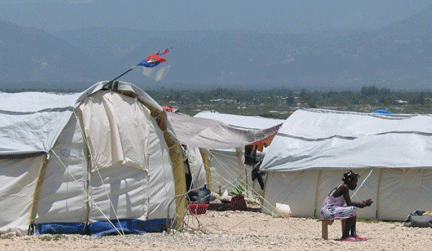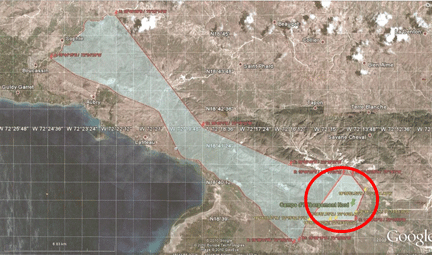Part 1 – Who is in charge and what is the plan?
“We went to City Hall, we didn’t learn anything. We went to Terre des Hommes, nothing… So far we haven’t gotten anything. Nothing. We are sitting here and we have no idea what anyone is thinking.”
- Rosie Benjamin, member of the Senta Park Camp Committee
“There is no plan for us to go anywhere. So far nobody has told us where to go.”
- Jean Widdy St. Felix, member of the Simon Bolivar Camp Committee
Nine months after the catastrophic earthquake which killed some 300,000 and left 1.3 million homeless, as reports and articles denounce the terrible conditions in Haiti’s 1,354 squalid refugee camps, Haiti Grassroots Watch decided to look into the issue.
• Is there a plan for the refugees, and if so, what is it?
• Who is in charge?
• Will it work?
A dozen interviews, scores of documents and many telephone calls later, Haiti Grassroots Watch discovered there actually does seem to be a plan. However, it is not readily accessible to the media or the Haitian public, it is so far only very loosely coordinated and thus far, is not overseen by any Haitian agency or ministry, making accountability difficult, if not impossible.
This article is the first in a series of three which examine the plan, its challenges and its workability.
Be sure to watch the videos, listen to the audio and to read the other articles:
Part 2 – What are the challenges?
Part 3 – Will it work?

Almost every week new reports and articles come out deploring the situation in the camps for internally displaced people. This photo is from a recent study of camp conditions and the roles played by NGOs called Unstable Foundations
Who is in charge?
While five Haitian government ministries are in some way involved with the issue (Planning, Interior, Public Works, Social Affairs and Economy and Finances), it appears that the planning and coordination of figuring out housing for Haiti’s 1.3 million internally displaced people has so far been overseen and managed by foreign entities – two of the 12 “Clusters” – the Shelter Cluster and the Camp Coordination and Camp Management (CCCM) Cluster.
“Clusters” are groupings of UN agencies, non-governmental organizations (NGOs) and other international organizations around a sector or service provided during a humanitarian crisis. International staff try to convene and coordinate NGOs and agencies according to area of intervention. [See our article The "Cluster" System in Haiti for more information]
National and local cluster meetings happen every week but minutes and reports from participants indicate that ministries rarely participate in the national Shelter or CCCM meetings, many of which are held in English. (On the other hand, cluster staff do interact with the government officials at the local level.)
Shelter Cluster Coordinator Gehard Tauscher told Haiti Grassroots Watch that the lack of coordination and participation at the national level is a roadblock, noting that he wished “all layers of the government would come together and speak with one voice.”
“I wish they would lock up all of the people in a nice place for a weekend – the UN, the agency people and the national government – and not let them out until they make decisions,” he said.
One Shelter Cluster staffer, Deborah Hyde, Information Manager for the Léogane Cluster, was a little less tactful in where to lay the blame.
“We need leadership and unfortunately in this country, the capacity for that is just not there,” Hyde told Haiti Grassroots Watch.
Tauscher and others acknowledged the national government didn’t immediately take up the housing issue in part due to the fact that it was directly hit by the earthquake – some 20 percent of state employees were killed or injured and seven of 11 ministries collapsed.
But nine months later, there still appears to be a lack of coordination and leadership.
The ministries’ absence might also be due to the apparent or real usurpation of power by the Interim Haiti Reconstruction Commission (IHRC), the 30-member commission headed by former U.S. President Bill Clinton and Haitian Prime Minister Jean Max Bellerive.
However, coordination between the IHRC and the Shelter Cluster also appears lacking. A Shelter Cluster Powerpoint obtained by Haiti Grassroots Watch dated Oct. 4 finishes with the following proposition - “Future… Cooperation/Integration of S[helter]C[luster] / Cluster System with the IHRC ? [sic]” which indicates that so far, “cooperation” and “integration” have not yet occurred.
Unfortunately, numerous attempts to speak with Haitian government authorities – ministry and IHRC – were met with closed doors and unanswered telephone calls.
Despite numerous attempts to interview members of the IHRC, including Priscilla Phelps, Senior Shelter Advisor to the Commission on a U.S. AID contract, Haiti Grassroots was instead referred to private businessmen – an ad hoc commission established in January but which does not appear to be functioning any more. It included banker Charles Clermont, Minister of Tourism Patrick Delatour who is also part-owner of a cement and construction company, and landowner, architect and developer Gerald-Emile “Aby” Brun.
Clermont and Delatour did not return calls and emails, and Brun, who owns land under part of the tract chosen for a planned camp, told Haiti Grassroots Watch to instead call the Ministry of the Interior and then joked “we’re all passing the buck, aren’t we?” When asked about the role of NGOs, plans for resettling camp residents and about the ongoing threats of eviction, he criticized the NGOs for “protecting squatters.”
What’s in the plan?
While no single institution has made any plan public, Haiti Grassroots Watch obtained a September 27 document entitled “Strategy of Return and Resettlement – Draft 5” (translated from French) which outlines the plan UN agencies and the Clusters are promoting.
According to sources in the Shelter Cluster, the plan has been given to “the Haitian government,” although it is not clear which ministries, agencies, commissions or offices.
The plan calls for, in order of feasibility:
“[1] Return to the original area; [2] Resettlement to the countryside where they are from or where they have land…; [3] Relocation to a planned site, as the final choice.”
The plan calls for camps to be progressively closed, and for “services to be progressively added to original neighborhoods and progressively diminished in the camps cut off in order to create a ‘pull factor.’”
In order to induce the camp residents out, they will also be offered what U.S. AID calls “returns packages.” The packages might include: cash ($150 for people from undamaged homes, an average of $1,000 for those who need to repair their homes), minimum wage “cash-for-work” job contracts and school tuition and food vouchers.
Because not everyone will fit in their old neighborhoods, and because some neighborhoods were in areas not suitable for housing, the rest of the people will be settled in the “planned site,” or sites, likely located on a 7,000-hectare piece of land the government declared “in the public interest” earlier this year.

7,000-hectare land. The Corail-Celesse planned camp is circled in red.
From a UN Habitat presentation.
Before building permanent homes, NGOs and agencies plan to build 135,000 “transitional” or T-shelters, which are 12- or 18-sq. meters, wooden or metal frame, plywood or plastic walls, and tin roof. The cost, including transportation, customs and labor, is about $1,500 - $2,500 each. Donors have already funded 120,000, meaning that about $240 million has been allocated for these. So far about 15,000 have been built.
The full 135,000 will not be completed until September, 2011, according to a recent Shelter Cluster document. In the meantime, various NGOs, like the US-based CHF International are working on small neighborhood-based projects.
Another example is Habitat for Humanity, which plans to build homes for 50,000 families across the country over the next five years, according to Director Claude Jeudy. But, he noted, so far there is no coordinated global plan that tells “each actor… what role they need to play… if there is a plan, I haven’t seen it.“
Back at the Shelter Cluster office, wall maps indicate which NGO has volunteered to coordinate resettlement in which area, but there are large white spaces on them, meaning that there is nobody – no NGO, no foreign or local agency, no UN agency – responsible for overseeing the people in the camps there.
“There are more agencies needed, to be shifted into these areas,” Tauscher said, pointing to Tabarre and to the capital’s infamous Cité Soleil slum.
In the meantime, St. Felix’s grandmother, who can’t take the heat under the tents at her camp, has moved back into her home. One wall has a giant crack running through it and another has fallen away completely. A sheet of blue plastic hangs in its place.
Benjamin is not so lucky. The September 24 storm soaked all her belongings and destroyed her tent. She and her family are bunking with a friend, in a stuffy, crowded, dusty tent where blue-tinted sun shining through the plastic walls makes her piles of clothing and dishes and pots look even more sordid and sad than they already are.
Part 2 – What are the challenges?
Part 3 – Will it work?
The "Cluster" System in Haiti
Back to Page 1 of Dossier #1 with links to video and audio

